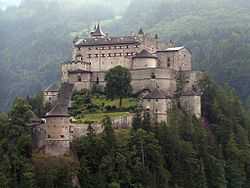Hohenwerfen Castle
| Hohenwerfen Castle | |
|---|---|
| Werfen Castle Austria | |
 | |
| Site information | |
| Site history | |
| Built | 1075–1078 |
| In use | Today as an adventure castle |
| Built by | Archbishop Gebhard of Salzburg |
Hohenwerfen Castle (German: Burg Hohenwerfen) stands high above the Austrian town of Werfen in the Salzach valley, approximately 40 km (25 mi) south of Salzburg. The castle is surrounded by the Berchtesgaden Alps and the adjacent Tennengebirge mountain range. The fortification is a "sister" of Hohensalzburg Castle both dated from the 11th century.
History
The former fortification was built between 1075 and 1078 during the Imperial Investiture Controversy by the order of Archbishop Gebhard of Salzburg as a strategic bulwark atop a 155 m (509 ft) high rock. Gebhard, an ally of Pope Gregory VII and antiking Rudolf of Rheinfelden, had three major castles extended to secure the Salzburg archbishopric against the forces of King Henry IV: Hohenwerfen, Hohensalzburg and Petersberg Castle at Friesach in Carinthia. Nevertheless Gebhard was expelled in 1077 and could not return to Salzburg until 1086, only to die at Hohenwerfen two years later.

In the following centuries Hohenwerfen served Salzburg's rulers, the prince-archbishops, not only as a military base but also as a residence and hunting retreat. The fortress was extended in the 12th century and to a lesser extent again in the 16th century during the German Peasants' War, when in 1525 and 1526 riotous farmers and miners from the south of Salzburg moved towards the city, laying fire and severely damaging the castle.

Alternatively it was used as a state prison and therefore had a somewhat sinister reputation. Its prison walls have witnessed the tragic fate of many 'criminals' who spent their days there - maybe their last - under inhumane conditions, and, periodically, various highly ranked noblemen have also been imprisoned there including rulers such as Archbishop Adalbert III, arrested by his own ministeriales in 1198, Count Albert of Friesach (in 1253), the Styrian governor Siegmund von Dietrichstein, captured by insurgent peasants in 1525, and Prince-Archbishop Wolf Dietrich Raitenau, who died here in 1617 after six years of imprisonment.
In 1931 the fortress, since 1898 owned by Archduke Eugen of Austria was again damaged by a fire and, though largely restored, finally had to be sold to the Salzburg Reichsgau administration in 1938. After World War II it was used as a training camp by the Austrian Gendarmerie (rural police) until 1987.
Nowadays the bastion, enlarged and renovated several times over the centuries, functions as an adventure castle for its visitors. Among the numerous attractions offered by the fortress are guided tours showing its extensive weapons collection, the historical Salzburg Falconry with the falconry museum as well as a fortress tavern. The historic Falconry Centre is a special attraction, offering daily flight demonstrations by various birds of prey.
Films
- Hohenwerfen was used as the castle 'Schloss Adler' in the 1968 film Where Eagles Dare, although the cable car scenes were filmed using the Feuerkogel-Drahtseilbahn in Ebensee as Hohenwerfen Castle has no cable car.
- Exterior shots of the castle were used as a French hotel in the movie Just Married.
- Exterior shots of Hohenwerfen Castle were used in the TV mini series The 10th Kingdom. In that series, it represented the Snow White Memorial Prison.
External links
| Wikimedia Commons has media related to Castle Hohenwerfen. |
Coordinates: 47°28′55″N 13°11′16″E / 47.48194°N 13.18778°E